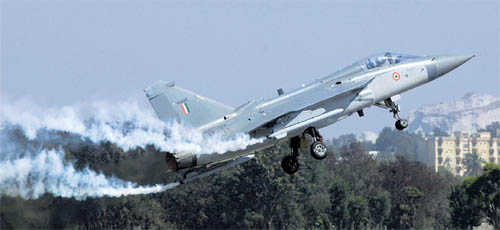
A file photo of the Tejas aircraft performing during the inauguration of the Aero India at Yelhanka air base in Bengaluru. PTI
Dinesh Kumar
In Sanskrit, tejas, the name given to India's indigenously developed light combat aircraft (LCA), means brilliance. On May 17, Chief of Air Staff Air Chief Marshal Arup Raha announced that the Indian Air Force (IAF) would induct its first squadron of Tejas in July, while giving the thumbs up after flying its trainer version. Much as this news may seem to be “brilliant”, the fact is that this hugely delayed aircraft is yet to get its final operational clearance which is currently rescheduled for December this year. Worse, the Tejas Mark-I (Mk-I) is a heavily compromised aircraft with significantly reduced operational capability. Besides, the IAF's first Tejas squadron will comprise a mere four aircraft, that is one-fourth the normal size of a fighter squadron, which will be only high on symbolism and undoubtedly far from tejas (brilliant).
The LCA's long journey began over three decades ago in 1983 when the government sanctioned the project followed by the constituting of the Aeronautical Development Agency (ADA) in June 1984. In October 1985, the IAF issued its list of requirements needed in the aircraft with a demand for 240 LCAs, including 20 trainers to be inducted by 1994. The LCA was supposed to replace the ageing Soviet-origin MiG-21s, the mainstay of the IAF, which were then scheduled to be phased out in the 1990s.
Incidentally, the LCA was conceived just as the IAF was retiring India's first indigenously developed fighter — the Hindustan Fighter (HF)-24, also known as Marut. The government then did not consider it worthy to upgrade and develop further variants of the HF-24 which had been conceived in 1955, designed by a reputed German aeronautical engineer (Kurt Tank), first test flown in 1961 and which later saw action in the 1971 Indo-Pak war. Instead, this aerodynamically well-designed single-seat twin-engine but under-powered ground attack aircraft was retired in 1985. The ADA thus started from scratch.
The LCA, as is the case with all major defence research and development projects, is a mind-boggling case study of delays, slippages, compromise and mismanagement (despite some hard work) that continues till date. There are two other disconcerting realities about the Tejas. First, the aircraft is far from indigenous, with only 35 per cent made in India and 65 per cent components sourced from overseas (mostly American and Israeli), making it an import-dependent aircraft. In fact, every major component starting from the engine and flight-control system to armaments is of foreign origin.
Second, the Tejas Mk-I has significant shortfalls, with 53 waivers and concessions. These shortfalls include lower engine thrust, higher weight, limited fuel capacity in the absence of drop tanks, markedly deficient self-protection jammers which limit its electronic warfare capability and the absence of Radar Warning Receivers and Counter Measures Dispensing System to name a few. Neither are there any certified trainer aircraft to train pilots. This has reduced the aircraft's operational capability and survivability, thereby limiting its operational utilisation. Although these shortcomings are expected to be overcome in the Mk-II version currently scheduled to be completed by December 2018, it could, however, take longer to complete considering the track record.
Consider the following: The LCA's first flight was originally scheduled for 1991, only to be revised to 1996, 1999 and 2000, before being first test flown in January 2001. Similarly, the induction schedule has been revised several times from the initial 1995 to 2003, 2005, 2008, 2010, 2012 and now 2018 (for the Mk-II), by when 35 years would have elapsed. In the meantime, owing to the inordinate delay in the development of the LCA, the government has already spent Rs 20,000 crore for upgrading 125 Soviet-origin MiG-21 Bis and 62 MiG-29 fighters, 61 British-origin Jaguar strike aircraft and the French Mirage-2000 even as the IAF's squadron strength has fallen from the sanctioned 42 to 33, with all MiG-23, MiG-25 and several MiG-21 squadrons having been retired.
There are several reasons behind the delay of the LCA. Apart from a period of post-May 1998 nuclear test sanctions, among the most notable has been India's inability to develop several key components which has necessitated design changes and purchases from overseas. This includes the failure to develop the Kaveri engine (started in 1989 with unending deadline revision to 1996, 2003, 2005, 2009, 2012 and currently unknown along with a cost escalation from the original Rs 383 crore to Rs 2,839 crore as of December 2009). This has necessitated a design modification each in the Mk-I variant for the American General Electric F-404 engine and in Mk-II for the F-414 engine.
The ADA was unable to develop the Multi-Mode Radar for tracking multiple targets (original deadline December 1997, with a deal for co-development with Israel finally signed in June 2009), the Flight Control System Actuators (currently American), Radome (British) and the Multi-Functional Display System (Israeli), among several other critical items. The IAF too ended up causing a delay of over seven years because it wanted changes in the armament: the Israeli R 73E close combat missile instead of the R-60; integration of the Israeli Derby and Python-5 beyond visual range missile; addition of the Russian 500 kg M-62 bombs; and a Counter Measures Dispensing System. Some of these features and armaments are yet to be incorporated in the Mk-I.
One hopes that the Tejas will not meet the same fate as that of the import-dependent “indigenous” Arjun tank which was conceived over four decades ago in 1974. Only 124 of the Arjun Mk-I are in service, while the Army still awaits the Mk-II. Clearly, the ADA with its 152 work centres engaged in developing the LCA needs to put in more tejas (brilliance) in developing the Tejas.



























